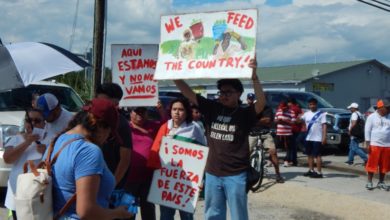The writer is the political chair of Columbia University’s Chicano Caucus. She spoke at the Socialism Conference in Los Angeles on Nov. 11. Click here to listen to her talk.
|
Karina Garcia speaking at a press conference supporting Columbia University anti-Minutemen protesters. |
The Oct. 4 protest at Columbia University against Minuteman Project co-founder Jim Gilchrist has raised some important questions. Should an armed vigilante group that has well-documented links to far-right, neo-Nazi and white supremacist extremist groups be allowed to speak in New York City, a city of immigrants, unchallenged?
Right-wing commentators and even Mayor Michael Bloomberg portrayed Gilchrist as an innocent victim of raving Columbia students. They condemned us for supposedly inhibiting his free speech.
To set the record straight, we did not inhibit anyone’s exercise of free speech. When we walked onstage with anti-racist banners promoting immigrant rights, we were violently attacked by Gilchrist’s supporters. We were the ones who were punched and kicked. Our banners were ripped from our hands and torn to shreds.
When Gilchrist walked offstage, it was because he and the Minutemen were isolated in the overwhelmingly pro-immigrant rights audience. Less than a week later, I appeared on WBAI’s “Democracy Now” program with Gilchrist. When I denounced him, he took off his microphone and left the studio.
The real issue with the Oct. 4 protest, as the radio debate further demonstrates, was not really about free speech. The Minutemen think the First Amendment means they have a right to espouse murderous racism without being challenged. The First Amendment says no such thing.
Gilchrist appears on stage with a suit instead of camouflage. But the Minutemen are not just espousing racist ideas. The presence of armed vigilantes on the border has only one purpose: to instill fear among impoverished Mexicans, desperate for work.
There are those who argue that these groups are part of a “radical fringe,” and that the best way to address them is to recognize their legitimacy, maybe to protest outside. I don’t share that view.
Like the Ku Klux Klan, for example, the Minutemen’s real strength is not in numbers but in the extent to which they can inspire fear among one sector of the society—in this case, among undocumented immigrants.
More ominously, the Minutemen’s combination of the threat of violence with xenophobic scapegoating has parallels with the Nazis in Germany in the late 1920s. Most agree that more Germans should have challenged Hitler’s fascist movement before it came to power. We who protested against Gilchrist on Oct. 4 stand in that tradition.
We can learn from the African American civil rights movement in this country. Whatever gains they made was through bold defiance and a broad spectrum of tactics, ranging from civil disobedience to challenging racists and Ku Klux Klan violence.
When we took the streets on May 1, leaving schools and work, our communities boldly stood up. Millions of people rejected the argument that we should be patient and wait for others to recognize our rights or that our actions would alienate the mainstream.
In the same way, our action on Oct. 4 was a message: Our people have stood up, and we won’t be intimidated by groups that try to keep us down with threats and intimidation.







